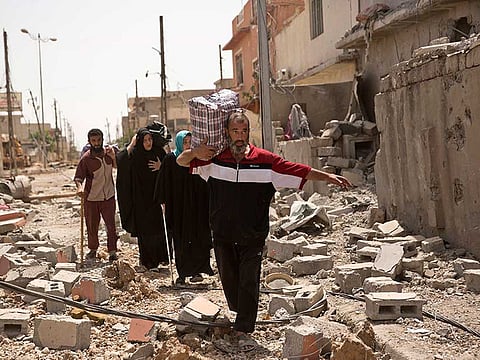US ramps up Daesh endgame effort
Post-Mosul, post-Raqqa, the intent will be to militarily squeeze this stretch of territory from each end

Washington: The United States is looking ahead toward a decisive battleground in its bid to destroy Daesh, even as US-backed local forces must still finish the fight for the extremists’ two main strongholds in Iraq and Syria.
The roughly 100-mile stretch of Daesh-controlled territory straddling the Iraq-Syria border could represent the start of an endgame for defeating an extremist group that had gobbled up large swaths of territory in the heart of the Middle East, at one point even threatening Baghdad.
Three years into America’s campaign, President Donald Trump is studying ways to accelerate the pace. He hasn’t yet announced results of a strategy review he ordered the Pentagon to undertake in late January in collaboration with the State Department and other agencies, but officials are already plotting how to wrest the final territories from Daesh’s control.
“ISIS [Daesh] will go down fighting, of course, and do enormous amounts of harm in its death throes,” Hal Brands and Peter Feaver, two US defence analysts, wrote in a recent assessment of how the extremist group will be defeated.
Defence Secretary Jim Mattis and General Joseph Dunford, the Joint Chiefs of Staff chairman, are to provide an update on the campaign at a Pentagon news conference on Friday. In Europe last week for talks with coalition partners, Mattis said the extremists have lost “well over” half their territory in Iraq and Syria since 2014.
Much fighting remains to fully expel Daesh from Mosul in northern Iraq, and the battle for the extremists’ self-declared capital of Raqqa, Syria, has barely begun.
But the follow-on battle lines are already clear. They will be drawn from the Syrian city of Deir Al Zor, which has come under increasing US aerial bombardment, to the western Iraqi city of Al-Qaim. The Pentagon refers to this area as the Middle Euphrates River Valley. Islamic State leaders and operatives have gravitated there in apparent anticipate of losing Mosul and Raqqa.
Post-Mosul, post-Raqqa, the intent will be to militarily squeeze this stretch of territory from each end, according to US officials.
American forces would support a group of Syrian Arab and Kurdish fighters known as the Syrian Democratic Forces driving southeast along the Euphrates from Raqqa toward Deir Al Zor, said the officials, who weren’t authorised to speak publicly on the military details and demanded anonymity. At the same time, Iraqi government forces, also supported by US advisers and air power, would advance toward Al Qaim.
And a separate US-backed group of Syrian rebels would push up from the south to block Daesh escape routes, the US officials said.
Deir Al Zor presents an especially tricky challenge because the Syrian military has a base there and the US has avoided tangling with President Bashar Al Assad’s forces other than an April 7 cruise missile strike.
The complexities of the campaign in Syria were illustrated by an unusual US air strike on Thursday against what the Pentagon described as Syrian pro-Assad forces near the Tang military camp close to the Jordanian border. US special operations forces have been working there with a Syrian opposition group in operations against Daesh.
A US military statement said Thursday’s strike occurred after Russia tried unsuccessfully to dissuade pro-Assad forces from advancing toward Tang.
The overall outlook is further clouded by the Syrian government’s announcement this month of a new military push aimed at reasserting its authority in east, including in Deir Al Zor and the remote desert area near Syria’s borders with Jordan and Iraq. Syrian Foreign Minister Walid Al Mua’allem said last week “the main goal” is to reach Deir Al Zor, an oil-producing region that was largely captured by Daesh during its great expansion of territory three years ago.
While the Middle Euphrates River Valley corridor may be the next key battleground, US officials believe it will not be the last. There are other pockets of extremist control in Iraq, including Hawija, west of Kirkuk. The situation is murkier in Syria given the mix of rebel groups involved, some of which occasionally ally with Al Qaida or Daesh. The US also must contend in the country with uncoordinated fighting forces from Turkey, Russia and Iran-backed militia such as Lebanon’s Hezbollah.
Military victory against Daesh isn’t by itself sufficient. Keeping Daesh or a follow-on extremist group out of liberated areas will likely depend on establishing stable governance and relieving humanitarian crises that have accumulated over years of war in both Syria and Iraq.
“Once we get that threat subdued, then the real work begins,” Mattis said this month in Copenhagen. Government services and normality must be restored, he said, “otherwise you simply breed the next problem.”
Sign up for the Daily Briefing
Get the latest news and updates straight to your inbox

